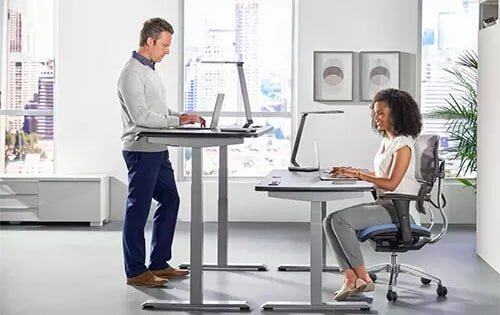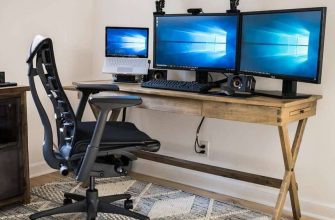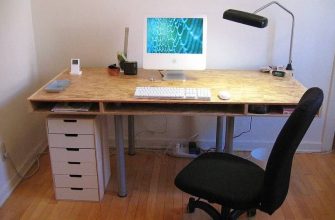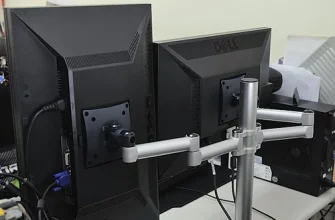The proper desk height ensures that you’re always in a healthy posture as it avoids neck and back pain, wrist, shoulder, and eye strain, etc.
That’s why it’s worth knowing the ideal height of a standing desk if you’re up to buying one for yourself. After all, a healthy posture helps create a productive workspace.
But, how high should a standing desk be? What is the proper standing desk height?
As a general rule of thumb, a standing desk height should be at your elbow height meaning standing desk height is the distance between your elbow and the floor.
For this height, when you’re standing up front at the desk, your back and shoulders must be straight, your forearms should be parallel to the ground, and your elbow must be at 90-degree.
Let’s discuss in more detail how you can maintain the right ergonomic posture and why it matters a lot when it comes to productivity.
- The Ideal Standing Desk Height
- What Is The Proper Height for Standing Desks?
- Do You Really Need a Standing Desk?
- 1. When You Want to Correct Your Posture
- 2. When You’re in a Shared Working Environment
- 3. When You Want to Improve Your Eyesight
- 4. If Your Desk is Being Used by Your Child
- How to Set up a Better Ergonomic Workspace: 6 Key Ergo Tips
- 1. Set the Desktop Height
- 2. Change the Keyboard & Mouse Position
- 3. Use Wrist Cushion Support
- 4. Change the Monitor Position & Angle
- 5. Get an Anti-fatigue Desk Mat
- 6. Take Frequent Breaks
- How Long Should You Stand at a Standing Desk?
- Conclusion
The Ideal Standing Desk Height

So as we said that the proper standing desk height is at your elbow height, but this desktop height will not work best for you in some cases.
The situation would be like if you’re working at the desk and have worn shoes or you’re working barefoot, in that case, the desktop height would be different.
It is also possible that you may have multiple pairs of shoes with different sole heights, then in that situation, the proper standing desk height would not remain the same.
Hence, to work in a comfortable posture, you’ll have to adjust the desktop height at your elbow height every time based on the shoes you’ve worn.
Whereas many standing desks also come with programmed memory preset height adjustability to let you find the best ergonomic height more easily.
And since different people have slightly different proportions, there are some calculated standing desk heights which you can see in the below table.
| Standing Desk Height for Person of | Standing Desk Height in inches | Standing Desk Height in cm |
| 5’0” | 36.5” | 152.4 |
| 5’1” | 37” | 154.94 |
| 5’2” | 37.5” | 157.48 |
| 5’3” | 38” | 160.02 |
| 5’4” | 39” | 162.56 |
| 5’5” | 39.5” | 165.1 |
| 5’6” | 40.5” | 167.64 |
| 5’7” | 41” | 170.18 |
| 5’8” | 41.5” | 172.72 |
| 5’9” | 42.5” | 175.26 |
| 5’10” | 43” | 177.8 |
| 5’11” | 43.5” | 180.34 |
| 6’0” | 44” | 182.88 |
| 6’1” | 44.5” | 185.42 |
| 6’2” | 44.5” | 187.96 |
| 6’3” | 46” | 190.5 |
| 6’4” | 47” | 193.04 |
| 6’5” | 47.5” | 195.58 |
| 6’6” | 48” | 198.12 |
| 6’7” | 49” | 200.66 |
| 6’8” | 49.5” | 203.2 |
What Is The Proper Height for Standing Desks?
So, with that given height measurements, it is clear that there is no fixed standing desk height for all people because no one size fits every person.
But the proper standing desk height would depend on the person height who is using the standing desk.
However, the above standing desk height is not the exact measurement for the range of people and can vary a few inches in certain cases such as when you’re wearing shoes.
Do You Really Need a Standing Desk?

So you know what is the ideal standing desk height, but now the major question is, do you really need a standing desk?
Is a standing desk a good idea?
To be honest, if you’re buying a standing desk only for yourself, there is usually no need to buy a stand-up desk, your sit-desk is good enough for your computer work.
But, there are some conditions where an ergonomic sit-stand desk can work better and provide more health benefits than a seated desk.
And these are the things that make buying an ergonomic height adjustable standing desk worth investment.
1. When You Want to Correct Your Posture
Whether you work in a seated position or standing, there is no doubt that working in a single position for a long period is bad for your health.
If you work for long hours in a standing position, it can negatively affect your leg muscles, tendons, and other connective tissue.
While research has linked sitting for long hours causes increased blood pressure, high blood sugar, excess body fat around the waist, and abnormal cholesterol levels.
But since standing desks offer height adjustability, you can alternate your position from sitting to standing and vice versa throughout the work sessions.
In that way, you can give your body a little exercise, some movement, and avoid physical illness that you would be facing working for long hours in a single position.
This is how a standing desk helps correct your posture and create better ergonomics. And this is the major reason which makes standing desks worth it.
2. When You’re in a Shared Working Environment
The second major reason could be when you’re working in a shared environment with a person of different heights.
Since a seated desk comes in a fixed height and does not offer height adjustability, working on these desks for different people could be uncomfortable.
They would not be able to find the right ergonomic posture to work comfortably and that may lead to physical issues such as neck, back, shoulder pain, etc.
In that situation, a height-adjustable stand-up desk can allow different people to set up the workspace at the most suitable level for their physical height.
3. When You Want to Improve Your Eyesight
If your computer monitor is not set at the right viewing angle or distance from your eyes, it may cause eye fatigue as well as head strain too.
As we know that seated desks have fixed heights, it can be much harder to set the monitor screen at the optimal height of your eyes.
But with a standing desk, you can easily raise or lower the desktop height and reach the monitor screen at the perfect viewing angle.
That is why a standing desk is what you need to improve your eyesight with a monitor screen and to be able to work easier on a monitor.
4. If Your Desk is Being Used by Your Child
Another situation when you could need a standing desk is if your children are using the same desk where you work on the computer.
But probably your kids weren’t able to find a comfortable posture since seated desks have fixed height and your kids are shorter than you.
In that case, a standing desk may help your children find the most suitable workspace, even after their height grows over time.
Despite all these worthy benefits from a health perspective, for most people, standing desks are not necessarily required.
But what is more important is taking frequent movement breaks throughout the work sessions so that you can energize your body and maintain a good ergonomic posture.
How to Set up a Better Ergonomic Workspace: 6 Key Ergo Tips
So now you know that establishing the right desk height is beneficial for health, and being healthy and focused brings productivity at work.
But standing desk height is not only an ergonomic factor, you’ve to make sure that other components such as the monitor, keyboard, and mouse are also in the perfect position.
Here are a few important tips that can help you set up better ergonomic posture, avoid body strain, and create a productive workspace.
1. Set the Desktop Height
Adjust the standing desk height and set up the desktop where your arms and wrist firmly rests on the keyboard and mouse and you’re able to type comfortably.
For instance, if your height is 5’8” then according to the above height measurements, the standing desk height needs to be set at 41.5” height from the floor.
2. Change the Keyboard & Mouse Position
Once you finish setting up the desktop height, the second step is to set up the keyboard and mouse at a suitable position (distance) from you.
Since computer work involves most working hours with keyboard and mouse, you’ve to make sure that both components must be set up at the right position for convenient use.
Place the keyboard and mouse at the same level close to each other and make sure when you’re using them, your elbows are at 90-degree and your wrist is straight parallel to the floor.
3. Use Wrist Cushion Support
In certain cases, you may feel wrist strain while typing on the keyboard and using the mouse even after setting up the desktop at the perfect height.
This may happen because the keyboard and mouse are not at the same height and here you’ll have to give your wrist extra cushion support.
A keyboard and mouse pad with wrist cushion support avoid joint and wrist problems and help release your elbows and shoulder stress for long hours of computer use.
4. Change the Monitor Position & Angle
The next key tip to improve your office ergonomics is to determine the monitor position and angle suitable for your viewing angle.
Positioning the monitor at a suitable height and angle from your eyes is an extremely important factor to avoid eyestrain and for healthy posture.
If the monitor is too far from your eyes, you’ll have to hunch your head forward to see the text on the monitor screen leading to eyestrain, poor posture, and productivity issues.
Place the monitor at an arm’s length of your line of sight, and the angle should be about 17-18 degrees below horizontal for optimal viewing.
This is the comfortable position of the monitor which allows you to view the entire screen without too much twisting or trunking forward or backward your head and neck.
Monitor mounting arm is a great tool that gives you the ability to adjust the monitor height, position, and angle by providing the perfect viewing angle for your eyes.
5. Get an Anti-fatigue Desk Mat
However working in a standing position has several health benefits but standing for excessive periods can cause sore feet, swelling of the legs, lower back pain, etc.
And for a productive workspace, being healthy should be your primary focus hence you’ll have to give your feet extra cushion support.
Anti-fatigue desk mat is the one you need that fights standing fatigue, relieves stiffness from your sore feet, and improves blood circulation so you can stand longer.
6. Take Frequent Breaks
Taking frequent breaks such as moving and stretching around the desk and resting a bit in between working sessions is also key to maintaining a productive workspace.
By taking breaks during intense working hours, you can clear your head, refresh your mood, energize your body, and fuel up your mind with positive energy.
A great way to remember all these is by installing software on your PC, setting a sedentary alert in your smartwatch, and reminder in your smartphone.
How Long Should You Stand at a Standing Desk?

So you know the ideal standing desk height, why it matters, and how you can create a better workspace with these desks.
Now the last thing which you must be aware of for a healthy office ergonomic is the ratio of alternating the posture between sitting and standing.
According to a study, you should stand at a standing desk for at least 30 minutes for every one to two hours of sitting to take the most health benefits of both standing and sitting.
Conclusion
Height adjustable stand-up desks are indeed excellent options for the healthy side but maintaining the right posture is also important for good ergonomics.
And if you’re even wondering about purchasing a standing desk then knowing the office ergonomics is very essential for you to have a productive workspace.
The above article has covered everything related to popper standing desk height, why it matters, and how you can create an ergonomically productive setup.
Hoping that you’ve found this article useful. If so, make sure to share it with your loved ones. It motivates us to bring more useful stuff for you. 🙂
Articles You May Also Find Useful:









